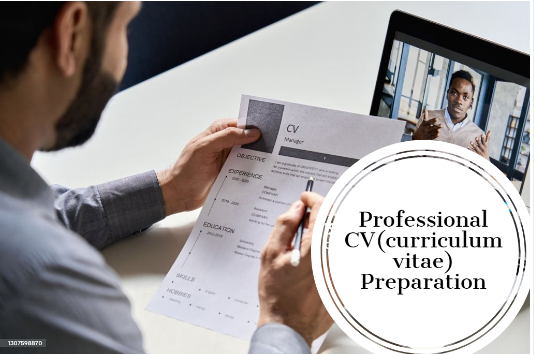
A professional CV is an essential tool for anyone looking to advance their career. It is the first impression that an employer has of a candidate, and it can make or break a job application. Therefore, it is crucial to make sure that your CV is well-prepared and effectively communicates your skills, experience, and achievements.
To prepare a professional CV, several key elements should be included. Firstly, it is important to tailor your CV to the position you are applying for. This means highlighting the skills and experience that are most relevant to the job. Secondly, the format and layout of your CV should be clear and easy to read. This includes using a professional font, bullet points, and headings to organize the information. Finally, your CV should be free of errors and typos, as these can detract from your professionalism.
In this article, we will provide a step-by-step guide on how to prepare a professional CV. We will cover everything from choosing the right format to highlighting your achievements and skills. By following these tips, you can create a CV that stands out and effectively communicates your value as a professional.
Understanding the Purpose of a CV
In the job application process, the first impression is crucial. A well-crafted CV (curriculum vitae) is an essential tool for securing your dream job. A CV is a document that outlines your education, work experience, achievements, and skills. It is used by employers to assess your suitability for a particular role.
Tailoring Your CV to the Job
One of the most important aspects of creating a professional CV is tailoring it to the job you are applying for. This means highlighting the skills and experiences that are most relevant to the job. It is essential to read the job description carefully and identify the key skills and experiences required for the role. Then, you can adjust your CV to showcase your relevant experience and skills.
The Difference Between a CV and a Resume
It is important to note that a CV is different from a resume. A resume is a shorter document that provides a brief summary of your work experience and skills. It is typically used for job applications in the United States. A CV, on the other hand, is a more comprehensive document that provides a detailed overview of your academic and professional accomplishments. It is commonly used in Europe and other parts of the world.
When preparing a professional CV, it is important to keep in mind the purpose of the document. It should showcase your skills, experience, and achievements in a way that is tailored to the job you are applying for. By understanding the purpose of a CV and tailoring it to the job, you can increase your chances of securing an interview and landing your dream job.
Structuring Your CV
When it comes to structuring your CV, there are several key sections that you should include to ensure that it is professional and well-organized. These sections include Contact Information, Professional Summary, Work Experience, Education, Skills, and Additional Sections.
Contact Information
The Contact Information section should include your full name, professional title, phone number, email address, and physical address. This information should be displayed prominently at the top of your CV so that potential employers can easily get in touch with you.
Professional Summary
The Professional Summary section should provide a brief overview of your skills, experience, and qualifications. This section should be no more than a few sentences long and should be tailored to the specific job that you are applying for.
Work Experience
The Work Experience section should list your previous employment history, including the name of the company, your job title, and your job responsibilities. This section should be organized in reverse chronological order, with your most recent job listed first.
Education
The Education section should list your academic qualifications, including the name of the institution, the degree that you earned, and your field of study. This section should also be organized in reverse chronological order, with your most recent degree listed first.
Skills
The Skills section should list your relevant skills and qualifications, including any certifications or licenses that you hold. This section should be tailored to the specific job that you are applying for, and should highlight your strengths and areas of expertise.
Additional Sections
The Additional Sections section can be used to include any additional information that is relevant to the job that you are applying for. This section could include information about your volunteer work, professional memberships, or other relevant experience.
By structuring your CV in this way, you can ensure that it is professional, well-organized, and easy to read. This will help you to stand out from other applicants and increase your chances of landing your dream job.

Professional CV(curriculum vitae) Preparation
Highlighting Your Achievements
When creating a professional CV, it is important to highlight your achievements to showcase your skills and experience. This section should focus on your accomplishments, rather than just your responsibilities.
Quantifying Success
One effective way to highlight your achievements is by quantifying your success. This means providing specific numbers and data to show how you have contributed to your previous roles. For example, instead of just stating that you increased sales, you could state that you increased sales by 25% within a specific time frame. This shows that you have tangible results to back up your claims.
To effectively quantify your success, consider using tables or bullet points to list specific accomplishments. This makes it easier for the reader to quickly understand your achievements and the impact you have had in your previous roles.
Relevant Projects and Roles
Another way to highlight your achievements is by focusing on relevant projects and roles. This means selecting specific examples that are relevant to the job you are applying for. For example, if you are applying for a project management role, you could highlight a specific project you managed and the results you achieved.
When selecting relevant projects and roles, consider the skills and experience required for the job you are applying for. This will help you tailor your achievements to the specific needs of the employer.
Overall, highlighting your achievements is an important part of creating a professional CV. By quantifying your success and focusing on relevant projects and roles, you can showcase your skills and experience in a way that is both effective and professional.
Design and Layout Considerations
When it comes to creating a professional CV, choosing the right design and layout is crucial. Here are some key considerations to keep in mind:
Choosing a Professional Template
Selecting a professional template is an essential step in creating a CV. Templates help ensure that your CV is organized and easy to read. There are many templates available online, so choose one that is appropriate for your industry and level of experience.
Here is a basic template you can follow when creating your CV
- Personal Information: Name, contact information, and professional social media profiles.
- Professional Summary: A brief statement that highlights your skills and experience.
- Work Experience: A list of your previous work experience, including job title, company name, dates of employment, and job responsibilities.
- Education: A list of your educational qualifications, including the name of the institution, degree, and date of graduation.
- Skills: A list of your relevant skills and abilities.
Consistency and Readability
Consistency and readability are crucial when it comes to the design and layout of your CV. Use the same font throughout, and make sure that your headings, subheadings, and body text are all clearly defined. Avoid using too many different fonts, colors, or styles, as this can make your CV look cluttered and difficult to read.
Appropriate Use of Color
Using color in your CV can help it stand out, but it is important to use it appropriately. Stick to a simple color scheme, and use color sparingly to highlight important information, such as headings or job titles. Avoid using bright or garish colors, as these can be distracting and unprofessional.
Final Review and Editing
After completing the first draft of the CV, it’s time to review and edit it for clarity, consistency, and accuracy. The final review and editing process is crucial to ensure that the CV stands out and presents the candidate in the best possible light.
Proofreading for Errors
The first step in the editing process is to proofread the CV for any errors, such as spelling mistakes, grammatical errors, or formatting issues. One way to do this is to read the entire CV out loud, which can help catch errors that might otherwise be missed. Another option is to use a spell-checker or grammar-checker tool to identify any errors automatically.
Feedback from Mentors and Peers
Getting feedback from mentors and peers is another important step in the editing process. This can help identify areas where the CV can be improved, such as the wording of certain sections or the overall structure. It’s important to choose mentors and peers who are knowledgeable about the industry and can provide constructive criticism.
Once the final review and editing process is complete, the candidate can feel confident that their CV is polished and professional. By taking the time to review and edit the CV, the candidate demonstrates attention to detail and a commitment to presenting themselves in the best possible light to potential employers.
Also Read;-

